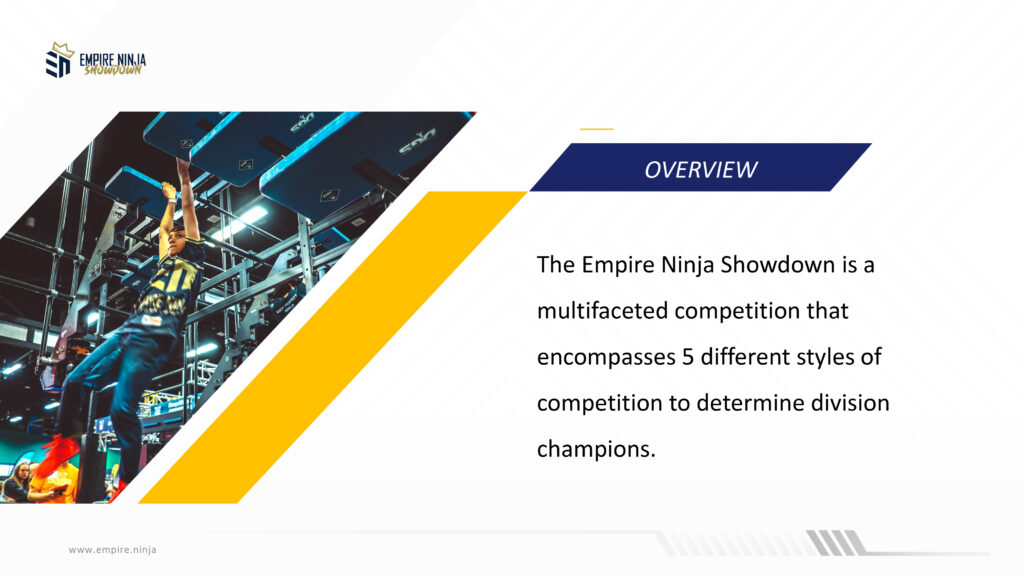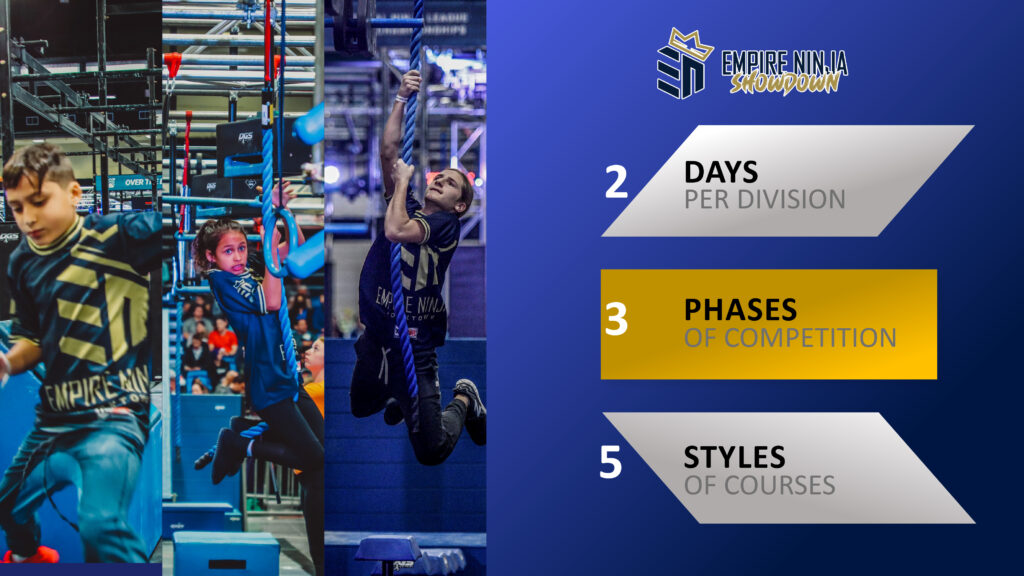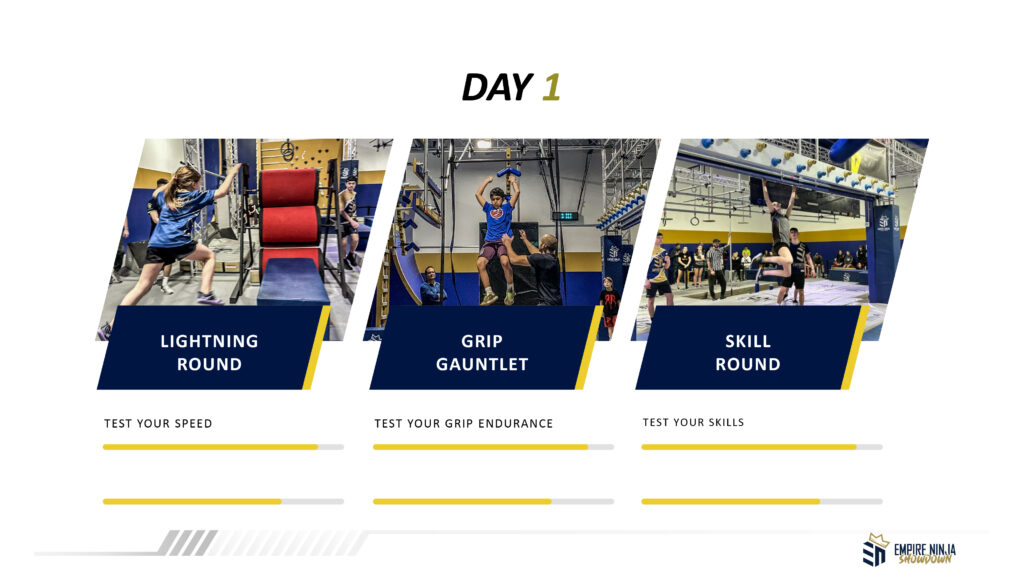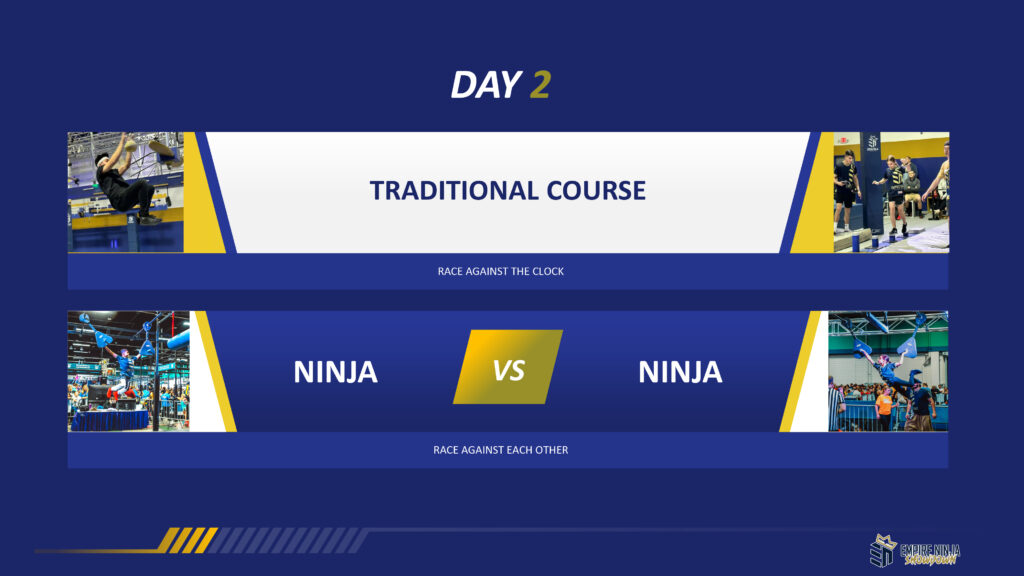
2024 DATES COMING SOON!
CASH PRIZES, GIFT CARDS, BRAGGING RIGHTS AND MORE!
OVERVIEW




SHOWDOWN DETAILS
1: Overview
The Empire Ninja Showdown is a multifaceted competition that encompasses 5 different styles of competition to determine division champions.
2: Divisions
(I) The athlete’s age division will be determined by their age ON the day of the competition. If the competition spans multiple days the athlete’s age division will be determined by their age on the final day of competition.
(II) The Age Divisions are as follows:
KID NINJA 6-8 years old
YOUTH NINJA 9-10 years old
TWEEN NINJA 11-12 years old
TEEN NINJA 13-14 years old
MATURE NINJA 15+ years old
PRO NINJA 15+ years old
(III) Athlete’s can only compete in one age division. Athlete’s who so desire will be allowed to compete in an older age division as long as it is the subsequent age division determined by the athlete’s age on the final day of competition of their ACTUAL designated age division. If an athlete so chooses to move up in age division they will not be allowed to compete in their actual age determined division. Additionally courses and skills will not be altered to accommodate a younger athlete who wishes to move up in age divisions.
(IV) Age divisions will be separated into Male and Female sub divisions. All rankings will be separated by these 2 sub divisions.
3: FORMATS
(I) The 5 styles of competition are outlined below:
(a) LIGHTNING ROUND: Athletes will compete on a course designed to test their speed. The fastest athlete through the most successful obstacle completions prior to or without failure will be the winner. Each subsequent time satisfying the aforementioned criteria of most successful obstacle completions prior to or without failure will determine the contiguous placement of the athletes. Athletes will be allowed one attempt on the Speed course without prior engagement on the course barring an incident that meets the requirements to warrant a rerun (outlined in section 5.II)
(b) GRIP GAUNTLET ROUND: Athletes will compete on a course designed to test their grip strength endurance. This course will consist of all upper body obstacles set in a continuous or “linked” manner. There will be no dismount platforms or designated resting areas. Athletes will traverse all obstacles until failure or full completion of the course. In the event that multiple athletes complete the same amount of obstacles the athlete that completed the final successful obstacle in the fastest time will place higher in the standings. Athletes will be allowed one attempt on the endurance course without prior engagement on the course barring an incident that meets the requirements to warrant a rerun (outlined in section 5.II).
(c) SKILLS ROUND: Athletes will compete in a predetermined number of challenges designed to test specific skills. Each skill station will be scored as it’s own individual event with athletes being given a point value based on their placement. The higher an athlete places the lower the point value awarded to them. (EX. in a field of 10 athletes first place would receive 1 point and tenth place would receive 10 points) The athlete with the lowest overall point total after all skills have been performed will be determined the winner of the skills competition. Athletes will be allowed one attempt at each skill station without prior engagement on the skill barring an incident that meets the requirements to warrant a rerun (outlined in section 5.II).
(d) TRADITIONAL ROUND: Athletes will compete in a traditional style competition on a course designed to test overall ability in multiple facets of ninja warrior such as balance, agility and grip strength. The course will be scored in the fashion of “furthest the fastest”. Athletes runs will end upon failure of an obstacle or full completion of the course. The fastest athlete through the most successful obstacle completions prior to or without failure will be the winner. Athletes will be allowed one attempt at the course without prior engagement on the obstacles barring an incident that meets the requirements to warrant a rerun (outlined in section 5.II).
(e) HEAD TO HEAD ROUND: Athletes will compete in a head to head race style competition on mirrored courses that share obstacles at various points on the course. The winner of any given race will be the athlete that either completes the course in it’s entirety the fastest or completes the most obstacles without failure. Athletes will compete multiple times on the course until either advancing to the subsequent round or being eliminated. Seeding and elimination will be outlined in section
4: Competition Structure
(I) PHASE ONE
(a) Encompasses the first 3 competitions as listed below:
Lightning Round
Grip Gauntlet Round
Skills Round
(b) Athletes will receive a rank value for each individual competition format. The higher an athlete places the lower the point value awarded to them. (EX. in a field of 10 athletes first place would receive 1 point and tenth place would receive 10 points)
(c) At the end of Phase One the individual format rankings will be added together to get an overall rank. The athlete with the lowest total amount of points will be ranked the highest. In the instance of a tie the athlete with the highest placement in any individual format will be awarded the tie breaker. If it is still tied (EX. both athlete’s best placement in any format was 2nd place) then their next highest placement will be considered and so on. In the minute chance that multiple athletes have identical points then the athlete with the most combined obstacle clears prior to failure in the Speed and Grip Gauntlet rounds will be awarded the tie breaker. If this number is the same then the lower overall time in the Speed and Grip Gauntlet rounds will determine the tiebreaker.
(d) The overall Ranking from Phase One will determine the run order for Phase Two, in which the highest ranked runs last and the lowest ranked runs first.
(II) PHASE TWO
(a) Phase Two will be the Traditional Round. Athletes will be awarded an individual ranking based on their placement in the traditional course. The higher an athlete places the lower the point value awarded to them. (EX. in a field of 10 athletes first place would receive 1 point and tenth place would receive 10 points)
(b) The athlete rankings from Phase One and Phase Two will be added together to determine the athlete’s NEW overall ranking. In the event of a tie between multiple athletes the athlete with the highest overall ranking in either PHASE ONE or PHASE TWO will be awarded the tie breaker. If it remains a tie the athlete with the highest placement in any individual format in both PHASE ONE and PHASE TWO will be awarded the tie breaker. If it is still tied (EX. both athlete’s best placement in any format was 2nd place) then their next highest placement will be considered and so on. In the minute chance that multiple athletes have identical points then the athlete with the most combined obstacle clears prior to failure in the Speed, Grip Gauntlet and Traditional rounds will be awarded the tie breaker. If this number is the same then the lower overall time in the Speed, Grip Gauntlet rounds will determine the tiebreaker.
(c) The New overall rankings will determine the seeding for PHASE THREE.
(III)PHASE THREE
(a) Phase Three is the final phase of the competition. Phase Three will consist of three brackets of head to head races.
(b)The athlete’s overall ranking determines their seeding in Phase Three and which bracket they fall into. Athletes in their respective gender subdivisions will be placed in brackets as follows
Athletes ranked 1-5 will be placed in Bracket 1 and get an automatic bye into the Showdown finals.
Athletes ranked 6-10 will be placed in Bracket 2 and get a first round bye.
All other athletes will be placed in Bracket 3
(1) Bracket 3 athletes will compete in a double elimination head to head competition. Highest seed vs Lowest seed
Ex. 10 athletes seeded 11-20
11 vs 20, 12 vs 19, 13 vs 18 etc.
The bracket is then divided into winners and losers.
Winners race winners and losers race losers.
This process continues until all but 3 athletes are eliminated by losing 2 races.
The final 3 competitors will advance into Bracket 2
(2) Bracket 2 athletes will repeat the exact same process as Bracket 3 with the highest seeds facing off against the lowest seeds.
The final 3 competitors will advance into Bracket 1
(3) Bracket 3 athletes will race all 7 of the other racers. The best record will be crowned the overall champion. In the event that multiple athletes are tied the head to head results of those athletes will be factored into a double elimination playoff.
Ex. Athletes A and B have ended with a record of 5 and 2.
Athlete A beat athlete B in their first race.
Athletes A and B would face off until one athlete has defeated the other twice.
If Athlete A wins the 2nd race they are awarded the championship. If Athlete B wins the 2nd race there would be 1 final race between them to decide the victor.
